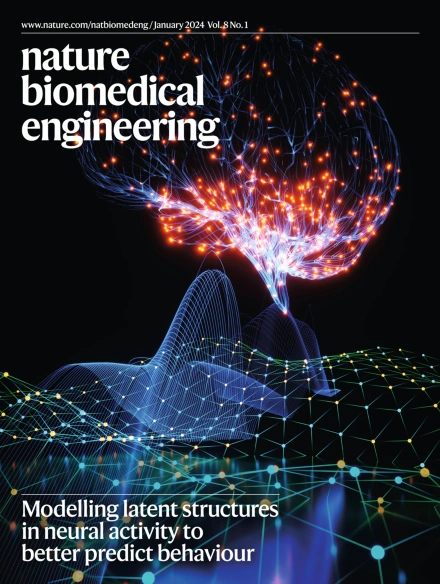一种基于人工纤毛的声频解码和共振响应药物释放阵列系统。
IF 26.8
1区 医学
Q1 ENGINEERING, BIOMEDICAL
引用次数: 0
摘要
人耳中的毛细胞含有不同长度的纤毛,可以感知不同的声音信号。在此,受此启发,我们报告了一种基于纤毛的人工声音解码设备,能够直接识别和响应声音频率,而不依赖于电力和算法。我们创建了3d打印微米大小(40-200 μm)的人造纤毛阵列,具有不同的长径比(30-100),可以在声学共振的基础上感知和解码声音频率信号(100-6,000 Hz),包括钢琴音乐和人声。人工纤毛也可以在水中相应地振动,以启动后续任务,例如以声频响应的方式控制两种不同疗法(胰岛素和胰高血糖素)的药物释放谱,以治疗1型糖尿病小鼠。这种受耳蜗纤毛启发的装置具有广泛的应用潜力,如识别复杂的生理声音和执行个性化语音交互中的各种任务。本文章由计算机程序翻译,如有差异,请以英文原文为准。
An artificial cilia-based array system for sound frequency decoding and resonance-responsive drug release.
Hair cells in the human ear contain cilia of varying lengths that sense varied acoustic signals. Here, inspired by this, we report an artificial cilia-based sound-decoding device capable of directly recognizing and responding to sound frequencies without relying on electricity and algorithms. We create 3D-printed micrometre-sized (40-200 μm) artificial cilia-based arrays with varying length-to-diameter ratios (30-100) that can sense and decode sound frequency signals (100-6,000 Hz), including piano music and human voices, on the basis of acoustic resonance. The artificial cilia can also vibrate accordingly in water to initiate subsequent tasks such as controlling drug release profiles of two distinct therapeutics (insulin and glucagon) in an acoustic-frequency-responsive manner to treat type 1 diabetic mice. This cochlear cilia-inspired device holds potential for broad applications such as recognizing complicated physiological sounds and performing various tasks in personalized voice interactions.
求助全文
通过发布文献求助,成功后即可免费获取论文全文。
去求助
来源期刊

Nature Biomedical Engineering
Medicine-Medicine (miscellaneous)
CiteScore
45.30
自引率
1.10%
发文量
138
期刊介绍:
Nature Biomedical Engineering is an online-only monthly journal that was launched in January 2017. It aims to publish original research, reviews, and commentary focusing on applied biomedicine and health technology. The journal targets a diverse audience, including life scientists who are involved in developing experimental or computational systems and methods to enhance our understanding of human physiology. It also covers biomedical researchers and engineers who are engaged in designing or optimizing therapies, assays, devices, or procedures for diagnosing or treating diseases. Additionally, clinicians, who make use of research outputs to evaluate patient health or administer therapy in various clinical settings and healthcare contexts, are also part of the target audience.
 求助内容:
求助内容: 应助结果提醒方式:
应助结果提醒方式:


